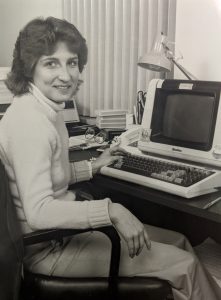Farewell to a 40-year career in ag communications
Farewell to a 40-year career in ag communications
 I’m just about to hang up my keyboard after 40 years in communications, almost all of it in ag. When you’ve been around longer than laptops, iPhones and the internet, you’ve seen a few things.
I’m just about to hang up my keyboard after 40 years in communications, almost all of it in ag. When you’ve been around longer than laptops, iPhones and the internet, you’ve seen a few things.
As a teenager who could type, my first two communications jobs were running phototypesetting machines for weekly newspapers. Those machines were as big as a desk, but one small step in the process of getting a newspaper printed. Today my morning papers arrive digitally.
In the early 1980s at MorganMyers, I could instantly communicate via a big Televideo computer in our Jefferson, Wis. office – using an unusually loud and persnickety dial-up modem – with our Velsicol client in downtown Chicago. Basically it was texting, but with computer terminals on both ends. That was cutting edge communications technology at the time.
I remember when MorganMyers bought our first “portable” computers. They were most definitely not portable and weighed something like 30 pounds. Our first “portable” phones were also on the large side. Hard to believe those Motorola bag phones were ever trendy. Now the iPhone in my pocket has 100,000 times more processing power than the Apollo 11 computer.
All those technological advancements made their way to farming. Watching that transition has been amazing. Today, tractors can drive themselves, apply inputs only when and where they’re needed – and at precise amounts, communicate with other equipment and collect all kinds of data to help farmers make management decisions.
By far one of the biggest changes I’ve seen in ag communications over four decades is how interested consumers have become in where their food comes from. I’ve always wondered if that all started because rBST was introduced for dairy cattle. While “They’re adding hormones to your milk!” is misleading, it’s also easy to understand.
What has really impressed me is how farmers have handled the increased scrutiny. They’ve thrown open their barn doors and invited people in. They’ve embraced social media to share stories of how farming has changed, and how important it is to protect their animals and the environment. After all, it’s how they make a living.
Unfortunately, farm tours are virtual right now thanks to COVID-19.
Speaking of … this spring, while millions of people (including me) hunkered down at home to ride out the pandemic, farmers didn’t have that luxury. They were out working to keep us fed. As I step away, I really hope there’s a renewed appreciation for the men and women who grow and raise our food. I’ve met a lot of them, listened to and told a lot of their stories, and leave with all the respect in the world for the job they do. Thanks for the opportunity.
 Back To Blog
Back To Blog

